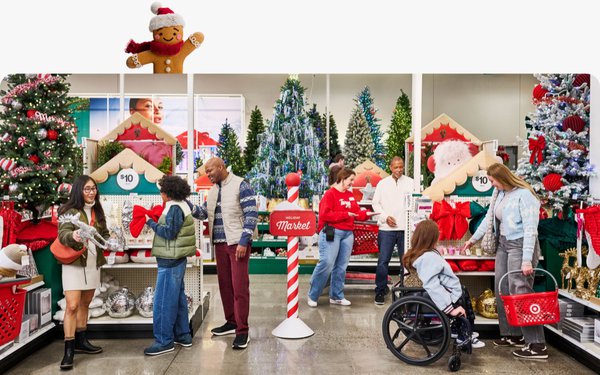
Target’s third quarter
landed where executives predicted. That’s the problem, and observers aren’t entirely sure the retailer has the solution. Net sales fell 1.5% to $25.3 billion, with comparable sales down
2.7%. Comparable sales in stores fell further -- 3.8%, only partly offset by a 2.4% gain in digital. The retailer also said it expects more bad news ahead in the fourth quarter, predicting a sales dip
in the low single digits.
In a call to discuss the results, incoming CEO Michael Fiddelke acknowledged the company is “far from satisfied” with yet another quarter of poor results.
He outlined three key areas to regain sustainable growth: solidifying Target’s design-led merchandising authority, solving its myriad executional problems, and making better use of technology to
speed the shopping experience.
advertisement
advertisement
The reality is that people are finding many reasons to skip Target altogether, and foot traffic data underscores how it lost its appeal. Placer.ai estimates
third-quarter visits fell 2.7% year-over-year, even as traffic rose 0.4% at Walmart and surged high single digits at TJX banners. October visits did tick up 0.9% after steep declines in August and
September, but that looks more like a brief promotional sugar high than a turn.
Brad Jashinsky, senior director analyst at Gartner, tells Retail Insider that while Target seems to
have some good ideas about its problems, “there’s no silver bullet. There’s so much economic volatility right now, and at the same time, Target is having a lot of executional
challenges.” Out-of-stocks and supply chain issues, many dating back to the pandemic, are still unsolved.
The Minneapolis-based company also can’t seem to shake off its people
problems, including a team smarting from last month’s layoffs, which eliminated 8% of positions at headquarters. Culture-war boycotts around DEI initiatives and Pride assortments, which
seem to have cooled off somewhat, haven’t gone away. “I think those are just a small part of the company’s problems,” Jashinsky says. “But they certainly haven’t
helped.”
“Target is really struggling and does not seem to be able to climb out of the hole it has dug itself,” writes Neil Saunders, managing director at GlobalData. He
points to a “doom loop where the investments needed to boost demand are shunned because of concerns over profit,” which then “limits the company’s ability to fix problems which
could boost the top line.”
Meanwhile, there just isn’t a compelling reason for shoppers to pick Target right now over other retailers. “You’re seeing Aldi, Walmart,
Amazon and many others filling those customer visits that used to go to Target,” Jashinsky says.
That doesn’t mean Target isn’t putting its
best foot forward for the holidays. The new “Step Into the Holidays” push turns stores into Alpine-village-style playgrounds, with a “Holiday Squad” of characters like the Get-Ready Yeti and Buttons the Gingerbread turning up in aisle displays, social content and giant
3D activations in New York and Los Angeles.
Target says it has doubled the number of new items to 20,000 this season, with more than half exclusive to the chain, and is leaning into buzzy
collaborations like “Stranger Things 5” merchandise and imported Marks & Spencer treats.
There’s plenty of tech gloss, too. A new
generative-AI gift finder in the app promises to help guests pick presents, and Target is one of the first big-box players to plug a shopping experience into ChatGPT, part of what it calls
“conversational curation.”
While that’s a potentially interesting development, Jashinsky notes, “it’s not going to change the business overnight.”
Both he and Saunders stress that the real work is operational and will be slow. Target is planning about $5 billion in capital expenditures next year, roughly $1 billion more than this year, along
with an additional $1 billion investment in operations and stores in 2026. Saunders calls resolving store-level issues -- out-of-stocks, messy aisles, long waits and locked cases -- “akin to
untangling a very knotted ball of yarn, something that is neither simple nor fast.”
Jashinsky puts the timetable bluntly. “Turnarounds take a
really long time,” he says. “These challenges are difficult even with all the power of different AI technologies. It requires a retraining of workforces, upskilling, and in a lot of cases,
changes in physical infrastructure and teams.”
While he expects to see some results by this time next year, turnarounds of this magnitude can take up to 18 months.
Meanwhile,
Target’s lapsed customers keep shopping elsewhere. Saunders says that plenty of people still have affection for Target. “That goodwill only stretches so far, and if Target does not
remedy its errors soon, it will drive more customers away. and the task of rebuilding will become much more of a challenge.”